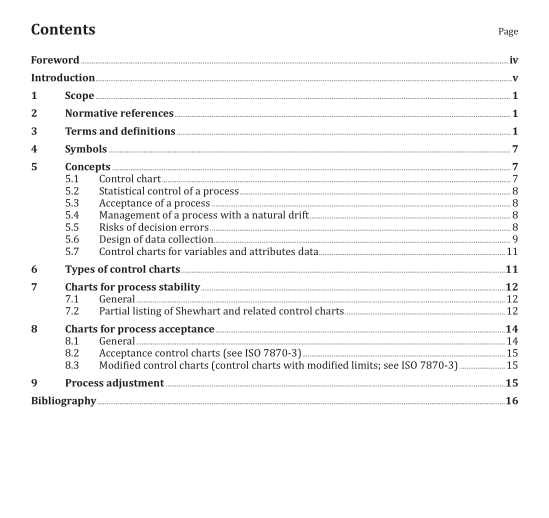ISO 7870-1:2014 pdf download.Control charts — Part 1: General guidelines
5 Concepts
5.1 Control chart
The control chart is a graphical display of data from the process, which allows a visual assessment of the process variability and stability. At defined intervals, subgroups of items of a specified size are obtained and the value of a characteristic or feature of the items is determined. The data obtained are typically summarized through the use of appropriate statistics and it is these statistics that are plotted on the control chart. A typical control chart will consist of a centre line that reflects the level around which the plotted statistic can be expected to vary. In addition, this control chart will have two lines, called control limits, placed one on each side of the centre line that define a band within which the statistic can be expected to lie randomly if the process is in control. The two control limits are used as a criterion for judging the state of control of a process.
The limits define a band, the width of which is determined in part by the inherent variability of the process. If the chosen statistic plots within the band, the chart is indicating that the process is in a state of statistical control and hence the process is allowed to continue operating as it is currently configured. However, a value of the statistic plotting outside the control limits indicates that the process can be “out of control”. The control chart is then providing a signal suggesting that a special cause of variability can be present and consequently there is a need for action on the process. Actions that can be taken on the process consist of
a) undertaking an investigation to determine the source(s) of a special cause(s), with a view to elimination, correction, or reduction of the effect of such cause(s) in the future, b) making a process adjustment,
c) continuing the process on a risk assessment basis,
d) stopping the process or taking containment action until correction has been made, and
e) retaining the special cause, making it permanent whenever possible in cases where special cause indications are of a positive nature (e.g. process improvement). Sometimes, a second set of limits called “warning limits” is also placed on the control chart. The observation of a plotted point falling outside the warning limits but not outside the control limits indicate that, although no “action” is required on the process, increased attention should be paid to the process since a suspicion has been raised that a special cause might have affected the process. It might prove advantageous to then shorten the interval of time to the next sample and/or increase the size of the next sample in order to more quickly determine if the process has undergone a change. When warning limits are included on the control chart, the control limits are then sometimes called “action limits”. Optional, additional rules used for judging the state of control of a process take various forms such as data points within limits but exhibiting unusual patterns. These rules, often called “decision rules”, are defined in ISO 7870-2. When the objective is that of process acceptance, additional limit(s), called acceptance limit(s), might be needed as a decision criterion to judge the process acceptability. See 5.3.
5.2 Statistical control of a process Control charts are often used to judge the stability of a process.
A process is considered to be in a “state of statistical control” (the process is effectively said to be “in statistical control”) if it is affected by random (or common or chance) causes only, i.e. if no extraordinary, unexpected, or special (or assignable) causes have entered the system. Such special causes can affect either the level at which the process is operating, the degree of variability around the process level, or both simultaneously. Variations due to random or chance causes occur in a random fashion and are usually found to obey certain statistical laws. In essence, when a process is “in statistical control” it is possible to predict reliably the behaviour of that process, whereas when special (or assignable) causes enter the system, the process is subject to the results of these causes and the outcome cannot be predicted without information about their presence and effect. A process found not to be in a state of statistical control is said to be “out of control” and requires intervention to bring it into such a state. For certain economic or natural phenomena, there might be no known way to intervene and the control chart simply serves to identify a lack of control.ISO 7870-1 pdf download.ISO 7870-1-2014 pdf download
